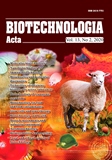ISSN 2410-7751 (Print)
ISSN 2410-776X (Online)

Biotechnologia Acta V. 13, No 2, 2020
Р. 38-47, Bibliography 22, English
Universal Decimal Classification: 579.63:577.29
https://doi.org/10.15407/biotech13.02.038
DETECTION OF SULFATE-REDUCING BACTERIA FROM VARIOUS ECOTOPES BY REAL-TIME PCR
D. R. Abdulina1, G. O Iutynska1, A. I. Aniskina2, M. M. Nikitin2
1D.K. Zabolotny Institute of Microbiology and Virology of the National Academy of Sciences of Ukraine, Kyiv
2GenBit LLC, Moscow, Russia
The study of detection effectiveness of sulfate-reducing bacteria (SRB) in the samples from various ecotopes by microbiological (cultural by serial dilutions) and molecular biological (by real-time PCR) methods with designed test-systems lyophilized on the silicon microchip was performed. The developed DSRM and SRB2 test-systems for detection of the functional gene dsrA presence, encoding one of the key enzyme of dissimilatory sulphate-reduction pathway — dissimilatory sulfite reductase were used. It was found that the minimal determined SRB titres in water samples were 104 cells/ml and in soil samples they were 102–105 cells/g of absolutely dry soil. In natural and man-caused samples, the amount of SRB detected by the microbiological method was correlated with calculated values determined by the molecular biological method, Pearson’s indexes were r = 0.41–0.69 (k = 11, P ≤ 0.01–0.05). Thus, real-time PCR assay with designed test systems lyophilized on the silicon microchips is a high-quality and rapid method for the detection of SRB in various natural and man-caused ecotopes.
Key words: dsrA gene, test-systems, sulfate-reducing bacteria, biocorrosion, real-time PCR.
© Palladin Institute of Biochemistry of National Academy of Sciences of Ukraine, 2020
References
1. Koch G. H., Brongers M. P. H., Thompson N. G., Virmani Y. P., Payer J. H. Corrosion cost and preventive strategies in the United States. NACE Inter. 2002, 773 p.
2. Li X., Liu Z.Y., Zhang D., Du C. Materials science: share corrosion data. Nature. 2015, V. 527, P. 441?442. https://doi.org/10.1038/527441a
3. Larsen K. R. A closer look at microbiologically influenced corrosion. Materials performance roundtable Q & A. NACE Inter. 2014, V. 53, P. 32?40.
4. NACE Standard TM0212-2012. “Detection, testing and evaluation of microbiologically influenced corrosion on internal surfaces of pipelines”. (Houston, TX, USA: NACE, 2012).
5. Kip N., van Veen J. A. The dual role of microbes in corrosion. ISME J. 2015, 9 (3), 542–551. https://doi.org/10.1038/ismej.2014.169
6. Barton L. L., Hamilton W. A. Sulphate-Reducing Bacteria. Environmental and Engineered Systems. Cambridge Univer. Press. 2010, 553 p. ISBN: 9780521854856
7. Andreyuk K. I., Kozlova I. P., Kopteva Zh. P., Pilyashenko-Novokhatny A. I., Zanina V. V., Purish L. M. Microbial corrosion of underground structures. Kyiv: Naukova dumka. 2005, 258 p. (In Ukrainian).
8. Iutynska G. A., Purish L. M., Abdulina D. R. Corrosive-relevant sulfidogenic microbial communities of man-caused ecotopes. Lambert Academic Publishing. 2014, 173 p. (In Russian).
9. Guan J., Zang B. L., Mbadinga S. M., Liu J. F., Gu J. D., Mu B. Z. Functional genes (dsr) approach reveals similar sulphidogenic prokaryotes diversity but different structure in saline waters from corroding high temperature petroleum reservoirs. Appl. Microbiol. Biotechnol. 2014, 98 (4), 1871?1882. https://doi.org/10.1007/s00253-013-5152-y
10. DSTU 3291-95 Unified system of corrosion and ageing protection. The methods of estimate of soil biocorrosion activity and determination of microbial corrosion sites on the surface of the underground metallic constructions. Derzhstandart, Kyiv. 28 p. (In Ukrainian).
11. GOST 34597-2019 Anodic earthing of the electrochemical protective installations against corrosion of underground metal constructions. Methods for determining the biocorrosion aggressiveness of soils and their impact on underground metal constructions. EASC, Minsk. 42 p. (In Russian).
12. Nikitin M. M., Stasyuk N. V., Franrsuzov P. A., Dzhavakhiya V. G., Golikov A. G. Matrix approach to the simultaneous detection of multiple potato pathogens by real-time PCR. J. Appl. Microbiol. 2018, V. 124, P. 797?809. https://doi.org/10.1111/jam.13686
13. Slyadnev M. N. Microchip-based systems for molecular genetic analysis. Rus. J. Gen. Chem. 2012, V. 82, P. 2154?2169. https://doi.org/10.1134/S1070363212120353
14. Shi Z., Yin H., Van Nostrand J. D., Voordeckers J.W., Tu Q. et al. Functional gene array-based ultrasensitive and quantitative detection of microbial populations in complex communities. mSystems. 2019, 4 (4) e00296-19. https://doi.org/10.1128/mSystems.00296-19
15. Abdulina D. R., Purish L. M., Iutynska G. A., Nikitin M. M., Golikov A. G. Test-systems for monitoring of corrosion-relevant sulfate-reducing bacteria using real-time PCR assay. Biotechnol. acta. 2016, 9 (1), 48?54. https://doi.org/10.15407/biotech9.01.048
16. Postgate J. R. The sulphate-reducing bacteria. Cambridge Univer. Press. 1984, 208 p.
17. Netrusov A. I., Egorova M. A., Zakharchuk L. M., Kolotilova N. N. Practice in microbiology. Moscow: Academia Publishing. 2005, 608 p. (In Russian).
18. Аndronov Е. Е., Pinaev А. G., Pershyna Е. V., Chizhevskaya Е. P. Metodical recommendations. DNA isolation from soils. [Metodycheskie rekomendacii. Videlenie DNK iz obrazcov pochv]. ARRIAM. Saint-Petersburg. 2011, 27 p. (In Russian).
19. Zaporozhenko E. V., Slobodova N. V., Boulygina E. S., Kuznetsov B. B., Kravchenko I. K. Method for rapid DNA extraction from bacterial communities of different soils. Microbiol. (Mikrobiologiya). 2006, 75 (1), 105?111. https://doi.org/10.1134/S0026261706010188
20. Nazina T. N., Feng Q., Kostryukova N. K., Shestakova N. M., Babich T. L., Ni Fangtian, Wang Jianqiang, Min Liu, Ivanov M. V. Microbiological and production characteristics of the Dagang High-temperature heavy oil reservoir (block no. 1) during trials of biotechnology for enhanced oil recovery. Microbiol. (Mikrobiologiya). 2017, 86 (5), 636?650. https://doi.org/10.1134/S0026261717050162
21. Vigneron A., Head I. M., Tsesmetzis N. Damage to offshore production facilities by corrosive microbial biofilms. Appl. Microbiol. Biotechnol. 2018, V. 102, P. 2525–2533. https://doi.org/10.1007/s00253-018-8808-9
22. Xu D., Jia R., Li Y. et al. Advances in the treatment of problematic industrial biofilms. World J. Microbiol. Biotechnol. 2017. V. 33, P. 97. https://doi.org/10.1007/s11274-016-2203-4

